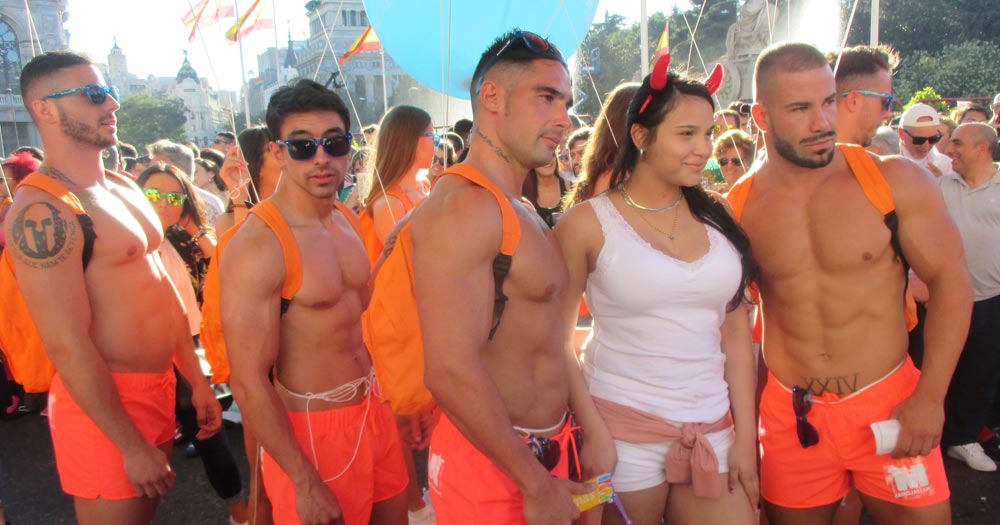“This is not just a gay-friendly city, we are a gay city and we are very proud of that.”
More than one and a half million people flooded Madrid amid tight security last weekend for WorldPride 2017, which for the first time combined WorldPride and EuroPride, with Madrid Pride going along for the ride, effectively making it a Pride trifecta. The festivities lasted ten days, ending on Sunday, July 2, with the passing of the baton to New York City, which will host WorldPride 2019, celebrating the 50th anniversary of Stonewall.
The WorldPride parade began on Saturday, July 1, at 5pm and didn’t conclude until after midnight, with two TV stations broadcasting the entire parade live. Local media reported that 1.5 million turned out to watch or participate.
The chance to capitalise on international LGBT visitors was not lost on tourism officials, who hoped Pride would encourage more tourists to regularly return to Madrid and other parts of Spain. Madrid more than lives up to its claim as being one of the world’s most welcoming cities for LGBTs, and has been recently voted the best LGBT+ city on the planet by Nestpick.
“This is not just a gay-friendly city, we are a gay city and we are very proud of that,” said Miguel Sanz, the director of Madrid’s tourism bureau. Sanz, who is gay, spoke last week before a press conference with LGBT journalist from the US, Canada, Latin America, Australia and other parts of Europe. He presented a promotional video showing male and female same-sex couples enjoying the city.
Traffic Signals
The tourism chief also reiterated the city’s slogan: “Whoever you love, Madrid loves you,” noting that the city’s gay friendliness extended even to the city’s traffic signals. Madrid has installed pedestrian walk/don’t walk signs that depict same-sex couples walking hand-in-hand at 72 intersections around the city. Those signs went up in advance of Pride in early June and the city plans to keep them in place.
Spain experienced a dramatic changes in LGBT acceptance in the years following the death of the country’s longtime dictator, Francisco Franco, in 1975. Spain’s first gay pride march was held in Barcelona in 1977 and a year later in Madrid, and homosexuality was legalised in 1979. Spain eventually more than made up for lost time when it became the third country in the world to legalise gay marriage in 2005.
In time for WorldPride, the city’s landmark Centro Palacio de Cibeles building includes a floor dedicated to the country’s LGBT history. Exhibits include photos of some of the early marches, as well as mug shots of people arrested for being gay under Franco’s regime, and even a shock-therapy machine designed to “cure” people of homosexuality.
Madrid’s Gay Neighbourhood
Many of WorldPride’s events were held in Madrid’s gay neighbourhood, Chueca, which evolved along with Spain’s acceptance. In the late 1970s, it was a downtrodden area best known as the place in the city to buy drugs. Gay entrepreneurs took advantage of the cheap real estate there, opening the first gay businesses in 1980. Others soon followed and today it is one of the city’s most attractive neighbourhoods. Chueca is also a favourite spot for tourists because of its wealth of restaurants and shops, just north of the city’s old historic centre.
WorldPride’s nine venues were spread out throughout the city. Three were in and around the Chueca gaybourhood. Some of Madrid’s famed landmarks served as backdrops for the eclectic entertainment presented throughout the ten-day celebration. The WorldPride Park took over the park along the Madrid River, near the historic Spanish royal castle. The city’s most tourist-popular square, Puerta del Sol, was another focal point for Pride entertainment. Chueca’s picturesque Pelayo Street was the scene of a longstanding Madrid Pride tradition, the famed high heels race.
WorldPride included a three-day international human rights summit that brought together more than 200 activists, politicians and leaders in the fields of education and culture. It is the first time that a Spanish-speaking country hosted WorldPride and the summit put a focus on LGBT rights in Latin America and its close continental neighbor, Africa. A separate conference was held over the same three days at the University Autonoma de Madrid to focus on HIV in the LGBT community, with panelists who discussed treatment and prevention strategies.
Suspected Terrorists
Organisers said they expected WorldPride would generate about €110 million worth of economic activity in Madrid during a traditionally slow time for tourism, but the city also returned much of that money in security and clean-up costs. Extra police were brought in and streets were sealed off and sealed off around entertainment venues, as well as during the parade on Saturday. Patrol cars were set up in the roads around the Pride celebrations to prevent vehicles from being used by terrorists, as has been seen most recently in Paris and London. Participants were searched before entering venues and glass bottles, or anything that could be used as a weapon, were not permitted inside. Just two days before WorldPride began, Spanish authorities arrested three men suspected of Jihadist terrorist activity.
WorldPride ended at midnight on Sunday evening, July 2, with a ceremony at which New York City officials were officially handed the reins of WorldPride. Creator of the rainbow flag, Gilbert Baker, who died in March was also honoured during the ceremony. Baker would undoubtedly have been proud to see his flag on virtually every street in Madrid and the rainbow colours of his flag projected on the city’s landmarks and fountains.
© 2017 GCN (Gay Community News). All rights reserved.




